Cremona
Cremona
Cremùna(Lombard) | |
|---|---|
| Comune di Cremona | |
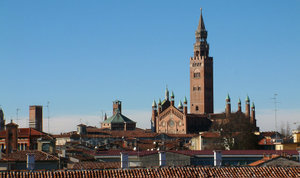 Panorama of Cremona | |
| Coordinates:45°08′00″N10°01′29″E/ 45.13333°N 10.02472°E | |
| Country | Italy |
| Region | Lombardy |
| Province | Cremona(CR) |
| Government | |
| • Mayor | Andrea Virgilio (PD) |
| Area | |
| • Total | 69.7 km2(26.9 sq mi) |
| Elevation | 47 m (154 ft) |
| Population (1 January 2021)[2] | |
| • Total | 71,223 |
| • Density | 1,000/km2(2,600/sq mi) |
| Demonym | Cremonesi |
| Time zone | UTC+1(CET) |
| • Summer (DST) | UTC+2(CEST) |
| Postal code | 26100 |
| Dialing code | 0372 |
| ISTATcode | 019036 |
| Patron saint | St.Homobonus |
| Saint day | 13 November |
| Website | Official website |
Cremona(/krɪˈmoʊnə/,[3][4]alsoUK:/krɛˈ-/;[5]Italian:[kreˈmoːna];Cremunés:Cremùna;Emilian:Carmona) is a city andcomunein northernItaly,situated inLombardy,on the left bank of thePo riverin the middle of thePianura Padana(Po Valley). It is the capital of theprovince of Cremonaand the seat of the local city and province governments. The city of Cremona is especially noted for its musical history and traditions, including some of the earliest and most renownedluthiers,such asGiuseppe Guarneri,Antonio Stradivari,Francesco Rugeri,Vincenzo Rugeri,and several members of theAmatifamily.[6]
History[edit]
Ancient[edit]
Celtic origin[edit]
Cremona is first mentioned in history as a settlement of theCenomani,aGallic(Celtic) tribe that arrived in thePovalley around 400 BC. However, the name Cremona most likely dates back to earlier settlers and puzzled the ancients, who gave many fanciful interpretations.
Roman military outpost[edit]
In 218 BC theRomansestablished on that spot their first military outpost (acolonia) north of the Po river, and kept the old name. Cremona and nearby Placentia (modernPiacenza,on the south bank of the Po), were founded in the same year, as bases for penetration into what became the RomanProvinceofGallia Cisalpina(Cisalpine Gaul). Due to the trade importance of the town, from it started theVia Brixianaaroman roadwhich connectedBrixia(Brescia) to Cremona.[7]
Cremona quickly grew into one of the largest towns in northern Italy, as it was on the main road connectingGenoatoAquileia,theVia Postumia.It supplied troops toJulius Caesarand benefited from his rule, but later supportedMarcus Iunius Brutusand theSenatein their conflict withAugustus,who, having won, in 40 BC confiscated Cremona's land and redistributed it to his men. The famous poetVirgil,who went to school in Cremona, had to forfeit his ancestral farm ( "too close to wretched Cremona" ), but later regained it.
Destruction[edit]
The city's prosperity continued to increase until 69 AD, when it was sacked and destroyed in theSecond Battle of Bedriacumby the troops ofVespasianunder command ofMarcus Antonius Primus,fighting to install him as Emperor against his rivalVitellius.The sacking was described byTacitusin Histories.[8]
Cremona was rebuilt with the help of the new emperor Vespasian, but it seems to have failed to regain its former prosperity as it disappeared from history.
Re-emergence[edit]
In the 6th century, it resurfaced as a military outpost of the Eastern Roman (Byzantine) Empire during theGothic War.
Early Middle Ages[edit]
When theLombardsinvaded much of Italy in the second half of the 6th century AD, Cremona remained aByzantinestronghold as part of theExarchate of Ravenna.The city expanded towards the north-west, with the creation of a great trenched camp outside the walls.
Lombard Possession[edit]
In 603 AD, Cremona was conquered by the Lombard KingAgilulfand again destroyed. Its territory was divided between the two duchies ofBresciaandBergamo.
However, in 615 AD, QueenTheodelinda,a devout Roman Catholic intent on converting her people, had Cremona rebuilt and re-installed a bishop there.
Holy Roman Vassal[edit]
Control of the city fell increasingly to its bishop, who became aHoly Roman Empirevassal afterCharlemagne's conquest of Italy. In this way, Cremona increased its power and its prosperity steadily and some of its bishops had important roles between the 10th and 11th centuries. BishopLiutprand of Cremonawas a member of the Imperial court under theSaxonydynasty andOldericgained strong privileges for his city from emperorOtto III.Its economy was boosted by the creation of a river port out of the former Byzantine fortress.
However, the two bishops Lambert and Ubaldo created discord with the city's people. EmperorConrad IIsettled the quarrel by entering Cremona in 1037 together with the youngPope Benedict IX.
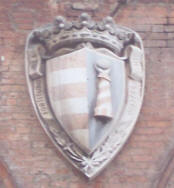
Medieval Commune[edit]
UnderHenry IV,Cremona refused to pay the oppressive taxes requested by the Empire and the bishop. According to a legend, the greatgonfaloniere(mayor)Giovanni Baldesio of Cremonafaced the emperor himself in a duel. As Henry was knocked from his horse, the city was saved the annual payment of the 3 kg (7 lb) golden ball, which, for that year, was instead given to Berta, Giovanni's girlfriend, as her dowry.
Anti-Empire[edit]
The first historical news about a free Cremona is from 1093, as it entered into an anti-Empire alliance led byMathilde of Canossa,together withLodi,MilanandPiacenza.The conflict ended with Cremona gaining theInsula Fulcheria,the area around the nearby city ofCrema,as its territory.
After that time, the new commune warred against nearby cities to enlarge its territory. In 1107 Cremona conqueredTortona,but four years later its army was defeated nearBressanoro.
As in many northern Italian cities, the people were divided into two opposing parties, theGuelphs,who were stronger in thenew city,and theGhibellines,who had their base in theold city.The parties were so irreconcilable that the former built a second Communal Palace, the still existingPalazzo Cittanova( "new city's palace" ).
Pro-Empire[edit]
WhenFrederick Barbarossadescended into Italy to assert his authority, Cremona sided with him in order to gain his support against Crema, which had rebelled with the help ofMilan.The subsequent victory and its loyal imperial stance earned Cremona the right to create a mint for its own coinage in 1154. In 1162, Imperial and Cremonese forces assaulted Milan and destroyed it.
Lombard League[edit]
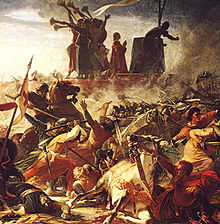
However, in 1167 the city changed sides and joined theLombard League.Its troops were part of the army that, on 29 May 1176, defeated Barbarossa in theBattle of Legnano.However, the Lombard League did not survive this victory for long. In 1213, atCastelleone,the Cremonese defeated the League ofMilan,Lodi,Crema,Novara,ComoandBrescia.
In 1232, Cremona allied itself with EmperorFrederick II,who was again trying to reassert the Empire's authority over Northern Italy. In theBattle of Cortenuova,the Cremonese were on the winning side. Thereafter Frederick often held his court in the city.
In theBattle of Parma,however, theGhibellinessuffered a heavy defeat and up to two thousand Cremonese were made prisoners. Some years later, Cremona took its vengeance by defeating Parma's army. Its army, under the command ofUmberto Pallavicino,captured Parma'scarroccioand for centuries kept the enemy's trousers hanging from theCathedral'sceiling as a sign of the rival's humiliation.
In 1301 thetroubadourLuchetto Gattilusiowaspodestàof Cremona. During this period Cremona flourished and reached a population of up to 80,000, larger than the 69,000 of 2001.
Seignory Lords[edit]
In 1266,Pallavicinowas expelled from Cremona, and the Ghibelline rule ended after his successorBuoso da Dovararelinquished control to a consortium of citizens. In 1271 the position ofCapitano del Popolo( "People's Chieftain" ) was created.
In 1276 theSignoriapassed to marquis CavalcabòCavalcabò;in 1305 he was succeeded by his son Guglielmo Cavalcabò, who held power until 1310. During this period many edifices were created or restored including the belfry of theTorrazzo,theRomanesquechurch of San Francis, the cathedral's transepts and the Loggia dei Militi. Moreover, agriculture was boosted with a new network of canals.
After some foreign invasions (notably that of EmperorHenry VIIin 1311), the Cavalcabò lasted until 29 November 1322, when a more powerful family, theViscontiofGaleazzo I,came to prominence that in Cremona was to last for a century and a half. The Visconti's signoria (lordship) was interrupted in 1327 byLudwig the Bavarian,in 1331 byJohn of Bohemia,and in 1403 by a short-lived return of the Cavalcabò. On 25 July 1406, captainCabrino Fondulokilled his employer Ubaldo Cavalcabò along with all the male members of his family, and assumed control over Cremona. However, he was unable to face the task, and ceded the city back to the Visconti for a payment of 40,000 golden florins.
ThusFilippo Maria Viscontimade his signoria hereditary. Cremona became part of theDuchy of Milan,following its fate until theunification of Italy.Under the Visconti and later theSforza,Cremona underwent high cultural and religious development. In 1411 Palazzo Cittanova become the seat of the university offustianmerchants.
In 1441 the city hosted the marriage ofFrancesco I SforzaandBianca Maria Viscontiin the temple built by theBenedictines,which today is the church of Saint Sigismund. For that occasion a newsweetwas devised, which evolved into the famoustorrone.[9]Ludovico il Moroassisted in the financing of several building projects for the cathedral, the church of St. Agatha and the Communal Palace.
In 1446, Cremona was encircled by thecondottieritroops ofFrancesco PiccininoandLuigi dal Verme.The siege was raised after the arrival ofScaramuccia da ForlìfromVenice.


Foreign occupations[edit]
Republic of Venice[edit]
From 1499 to 1509 Cremona was under Venetian control.
The victory of the Italian League atAgnadellogave it back to the Duchy of Milan.
Spain[edit]
However, Cremona was assigned toSpainunder theTreaty of Noyon(1513). Cremona fell to the new rulers only in 1524 when the Castle of Santa Croce surrendered. The French were finally expelled from the duchy two years later, with theTreaty of Madrid,and subsequently Cremona remained a Spanish dominion for many years. During that time several building improvements or additions were made, including the Loggia of the cathedral's Porch byLorenzo Trotti(1550) and the new church of San Siro and Sepolcro byAntonio Gialdini(1614).
During Spanish rule, Cremona saw the famine of 1628 and theplague of 1630.
Austria[edit]
The duchy, after a short-lived French conquest in 1701 during theWar of the Spanish Succession,passed to Austria on 10 April 1707.

For later history, seeLombardy
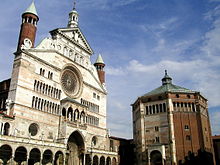
Government[edit]
Architecture[edit]
Churches[edit]
TheCathedral of Cremonawith the annexedBaptisteryconstitutes one of the most notable sites for Romanesque-Gothic art in northern Italy.
Other churches include:
- Sant'Agata
- Sant'Agostino
- San Facio
- San Girolamo
- San Luca
- Santa Lucia
- San Marcellino
- San Michele
- San Pietro al Po
- Santa Rita
- San Sigismondo
Buildings[edit]
- TheTorrazzo,the third highestbrickworkbell tower in Europe
- Loggia dei Militi
- Palazzo Cittanova
- Palazzo Fodri
- Palazzo Comunale
- Teatro Ponchielli
- Museo Berenziano
- Museo della Civiltà Contadina
- Museo Civico Ala Ponzone
- Museo del violino
Economy[edit]
The economy of Cremona is deeply linked to the agricultural production of the countryside. Food industries include salted meat, sweets (torrone), vegetable oils,grana padano,provoloneand "mostarda"(candied fruit in spicy mustard-flavored syrup, served with meats and cheese). Heavy industries include steel, oil and one electric plant. The river-port is a base for the barges transporting goods along the Po river.
Music[edit]
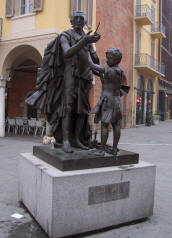

Cremona has a distinguished musical history. The 12th-century cathedral was a focus of organized musical activity in the region in thelate Middle Ages.By the 16th century the town had become a famous musical centre. Nowadays there are importantensemblesfor Renaissance and Baroque music, i.e.Choir & ConsortCostanzo Porta,and festivals which maintain Cremona as one of the most important towns in Italy for music. ComposerMarc'Antonio Ingegneritaught there;Claudio Monteverdiwas his most famous student, before leaving forMantuain 1591. Cremona was the birthplace ofPierre-Francisque Caroubel,a collaborator with noted German composerMichael Praetorius.Thebishop of Cremona,Nicolò Sfondrati, a fervent supporter of theCounter-Reformation,becamePope Gregory XIVin 1590. Since he was an equally fervent patron of music, the renown of the town as a musical destination grew accordingly.
Beginning in the 16th century, Cremona became renowned as a centre of musical instrument manufacture, with the violins of theAmatiandRugerifamilies, and later the products of theGuarneriandStradivariworkshops.[10]To the present day, their handmade work is widely considered to be the summit of achievement in string instrument making. Cremona is still renowned for producing high-quality instruments, rare examples of which can be seen when visiting the localMuseo del Violino.In 2012 the "Traditional violin craftsmanship in Cremona"was declared anintangible cultural heritagebyUNESCO.[11][12]Internationally, the city's craftsmen are renowned for the unique process used in crafting bowed stringed instruments which are assembled and moulded by hand without using any industrial materials.[13]
Cremona had a band tradition linked to theGuardia nazionalefounded under Napoleonic influence. In 1864, native sonAmilcare Ponchiellibecame its leader and created what might be considered one of the greatest bands of all time. In his role ascapobanda,Ponchielli founded a band school and a tradition that waned only at the onset ofWorld War I.
Transport[edit]
Cremona railway station,opened in 1863, is a terminus of six railway lines, all of which are regional (semi-fast) or local services.
Main destinations arePavia,Mantua,Milan,Treviglio,Parma,Brescia,PiacenzaandFidenza.
Sport[edit]
Cremona's favourite sport isfootball.TheU.S. Cremoneseplayed for several years inSerie A,its most renowned players beingAristide Guarneri,Emiliano Mondonico,Antonio CabriniandGianluca Vialli— all born in or near Cremona. The brightest page in the more than one-century-old history of Cremonese was written in the early 1990s, when the president of the team was Domenico Luzzara and the coach wasGigi Simoni;the team managed to stay in Serie A for three consecutive years, ending one championship at tenth place. By defeating English teamDerby Countyin the Final to win theAnglo-Italian Cup(27 March 1993), Cremonese became the second Italian team in football history to win atWembley.
Cremona, by the 1980s, had built a strong basketball tradition, now brought on byVanoli Basket,a team fromSoresinawhich however usually plays in Cremona.
Cremona has also awaterpoloclub that play in the regional divisions. There is a century-old tradition inrowingandcanoe racing,with three different clubs, located along the Po river, that trained many world and Olympic champions.




Twin towns — sister cities[edit]
Cremona istwinnedwith:
 Alaquàs,Spain, since 2004
Alaquàs,Spain, since 2004 Krasnoyarsk,Russia, since 2006
Krasnoyarsk,Russia, since 2006 Füssen,Germany, since 2018
Füssen,Germany, since 2018
Notable people[edit]
Notable people born in or associated with Cremona include:
- Publius Quinctilius Varus(46 BC – AD 9), Roman general and politician
- Marcus Furius Bibaculus(103 BC –? BC), a Roman poet.[14]
- Liutprand of Cremona(c. 920– 972), bishop of Cremona, historian, and author.[15]
- Saint Homobonus,(12th C.)patron saintof Cremona, as well asbusiness people,tailors,shoemakers,andclothworkers
- Gerard of Cremona(ca.1114 – 1187), translator of scientific books from Arabic into Latin.[16]
- Sicard of Cremona(1155–1215), prelate, historian and writer
- Bernardino Ricca(1450-?), painter[17]
- Filippo de Lurano(ca.1475 – after 1520), an Italian composer of the Renaissance.
- Marco Girolamo Vida(ca.1489 – 1566), scholar, Latin poet and bishop.[18]
- Altobello Melone(ca.1490 – pre-1543) an Italian painter of the Renaissance.
- Francesco and Giuseppe Dattaro(ca.1495 – 1576) & (ca.1540 – 1616), father and son team of architects
- Girolamo del Prato(16th C.), sculptor and craftsman
- Gianello della Torre(ca.1500 — 1585) Italo-Spanish clockmaker, engineer and mathematician.
- Giulio Campi(1500–1572), painter.[19]
- Andrea Amati(1505–1577),luthier.[20]
- Bernardino Campi(1522–1592), painter.[21]
- Costanzo Porta(ca.1528 – 1601), an Italian composer of the Renaissance
- Sofonisba Anguissola(ca.1532 – 1625), painter of the Renaissance.[22]
- Benedetto Pallavicino(ca.1551 – 1601), an Italian composer and organist of the late Renaissance.
- Claudio Monteverdi(1567–1643), composer of the late Renaissance and early Baroque eras.[23]
- Giulio Calvi(ca.1570 – 1596), an Italian painter of the Renaissance.
- Luca Cattapani(born ca.1570) an Italian painter of the late-Renaissance
- Gaspare Aselli(1581–1626), physician.[24]
- Tarquinio Merula(1595–1665), an Italian composer, organist and violinist of the early Baroque era.
- Nicolò Amati(1596–1684), luthier.[25]
- Francesco Rugeri(ca.1628–1698), luthier
- Antonio Stradivari(c.1644–1737), renowned luthier.[26]
- Vincenzo Rugeri(1663–1719), luthier
- Luigi Guido Grandi(1671–1742), monk, priest, philosopher, theologian, mathematician, and engineer
- Giuseppe Guarneri(1698–1744), luthier
- Francesco Bianchi(1752–1810), an Italian opera composer.
- Giovanni Pallavera(1818–1886), painter
- Amilcare Ponchielli(1834–1886), composer.[27]
- Eugenio Beltrami(1835–1900), mathematician
- Arcangelo Ghisleri(1855–1938), an Italian geographer, writer and Socialist politician.
- Leonida Bissolati(1857–1920), leading exponent of the Italiansocialistmovement at the turn of the 19th C.
- Primo Mazzolari(1890–1959), priest and writer
- Roberto Farinacci(1892–1945), fascist politician
- Aldo Protti(1920–1995), an Italian baritone opera singer
- Ugo Tognazzi(1922–1990), actor, director, and screenwriter
- Mina(born 1940), singer (nicknamed theTiger of Cremona)
- Giovanni Lucchi(1942–2012), bowmaker
- Franco Mari(born 1947), an Italian actor and comedian.
- Sergio Cofferati(born 1948), member of European Parliament and former mayor of Bologna
- Massimo Capra(born 1960), Italian-born Canadian celebrity chef.[28]
- Sandrone Dazieri(born 1964), crime writer
- Alessandro Magnoli Bocchi(born 1968), Italian economist
- Chiara Ferragni(born 1987), blogger, businesswoman, fashion designer and model
- Quartetto di Cremona(formed 2000), Italian string quartet
Sport[edit]
- Oreste Perri(born 1951), sprint canoeist in the 1970s and mayor of Cremona from 2009 to 2014
- Antonio Cabrini(born 1957), footballer and manager
- Gianluca Vialli(1964–2023), footballer and manager
- Manolo Guindani(born 1971), retired footballer and manager
- Giacomo Gentili(born 1997), world rowing champion
Climate[edit]
| Climate data for Cremona (1981–2010) | |||||||||||||
|---|---|---|---|---|---|---|---|---|---|---|---|---|---|
| Month | Jan | Feb | Mar | Apr | May | Jun | Jul | Aug | Sep | Oct | Nov | Dec | Year |
| Mean daily maximum °C (°F) | 4.9 (40.8) |
7.5 (45.5) |
13.5 (56.3) |
17.6 (63.7) |
23.2 (73.8) |
27.4 (81.3) |
29.9 (85.8) |
29.0 (84.2) |
24.2 (75.6) |
17.5 (63.5) |
10.4 (50.7) |
6.0 (42.8) |
17.6 (63.7) |
| Daily mean °C (°F) | 2.4 (36.3) |
4.3 (39.7) |
9.4 (48.9) |
13.4 (56.1) |
18.8 (65.8) |
22.7 (72.9) |
25.1 (77.2) |
24.5 (76.1) |
20.1 (68.2) |
14.4 (57.9) |
8.0 (46.4) |
3.8 (38.8) |
13.9 (57.0) |
| Mean daily minimum °C (°F) | −0.1 (31.8) |
1.1 (34.0) |
5.3 (41.5) |
9.2 (48.6) |
14.3 (57.7) |
17.9 (64.2) |
20.3 (68.5) |
20.0 (68.0) |
16.0 (60.8) |
11.3 (52.3) |
5.6 (42.1) |
1.6 (34.9) |
10.2 (50.4) |
| Averageprecipitationmm (inches) | 63 (2.5) |
61 (2.4) |
66 (2.6) |
77 (3.0) |
71 (2.8) |
69 (2.7) |
53 (2.1) |
70 (2.8) |
62 (2.4) |
100 (3.9) |
100 (3.9) |
67 (2.6) |
859 (33.7) |
| Source: Istituto Superiore per la Protezione e la Ricerca Ambientale (precipitation 1951–1980)[29] | |||||||||||||
References[edit]
- ^"Superficie di Comuni Province e Regioni italiane al 9 ottobre 2011".Italian National Institute of Statistics.Retrieved16 March2019.
- ^Population data fromIstat
- ^"Cremona".The American Heritage Dictionary of the English Language(5th ed.). HarperCollins.Retrieved1 August2019.
- ^"Cremona".Collins English Dictionary.HarperCollins.Archivedfrom the original on 1 August 2019.Retrieved1 August2019.
- ^"Cremona".LexicoUK English Dictionary.Oxford University Press.Archived fromthe originalon 2020-03-22.
- ^Yin, Steph (20 December 2016)."Science behind Stradiveri violins".The New York Times.Archivedfrom the original on 2017-10-03.Retrieved2017-03-01.
- ^"VIA BRIXIANA"(in Italian).
- ^Tacitus, Publius (25 June 2009).The Histories.Penguin. p. 133-134.ISBN978-0-140-44964-8.
- ^This is the legend promulgated by the sweets industry in Cremona, although there is no historical evidence of its veracity.
- ^Yin, Steph (20 December 2016)."Stradivari violin wood".The New York Times.Archivedfrom the original on 2020-05-27.Retrieved2017-03-01.
- ^"Traditional violin craftsmanship in Cremona".UNESCO(in English, French, and Spanish).Archivedfrom the original on 2017-01-07.Retrieved2017-02-07.
- ^"Decision of the Intergovernmental Committee: 7.COM 11.18".UNESCO.Archivedfrom the original on 2017-02-08.Retrieved2017-02-15.
- ^Colombo, Sergio."The dark future for the world's greatest violin-makers".bbc.Archivedfrom the original on 2020-07-08.Retrieved2020-07-14.
- ^.Encyclopædia Britannica.Vol. 3 (11th ed.). 1911. p. 849.
- ^.Encyclopædia Britannica.Vol. 16 (11th ed.). 1911. p. 800.
- ^Beazley, Charles Raymond(1911)..Encyclopædia Britannica.Vol. 11 (11th ed.). p. 764.
- '^Abecediario biografico dei pittori, scultori ed architetti Cremonesi(1827), by Giuseppe Grasselli and Giovanni Valle. Omobono Manini, publisher. Pages 222-223.
- ^.Encyclopædia Britannica.Vol. 28 (11th ed.). 1911. p. 47.
- ^.Encyclopædia Britannica.Vol. 5 (11th ed.). 1911. p. 136.
- ^.Encyclopædia Britannica.Vol. 1 (11th ed.). 1911. p. 783.
- ^.Encyclopædia Britannica.Vol. 5 (11th ed.). 1911. p. 136.
- ^.Encyclopædia Britannica.Vol. 2 (11th ed.). 1911. p. 44.
- ^.Encyclopædia Britannica.Vol. 18 (11th ed.). 1911. p. 778.
- ^.Encyclopædia Britannica.Vol. 2 (11th ed.). 1911. p. 724.
- ^.Encyclopædia Britannica.Vol. 1 (11th ed.). 1911. p. 783.
- ^.Encyclopædia Britannica.Vol. 22 (11th ed.). 1911. p. 977.
- ^.Encyclopædia Britannica.Vol. 22 (11th ed.). 1911. p. 59.
- ^Maher, Michelle (November 25, 2011)."Chef Massimo heats it up at Eight Words Café".SaskToday.ca.Archivedfrom the original on 2023-03-05.Retrieved2022-08-07.
- ^"Valori climatici normali di temperatura e precipitazione in Italia"(PDF).Istituto Superiore per la Protezione e la Ricerca Ambientale.Retrieved28 June2024.





